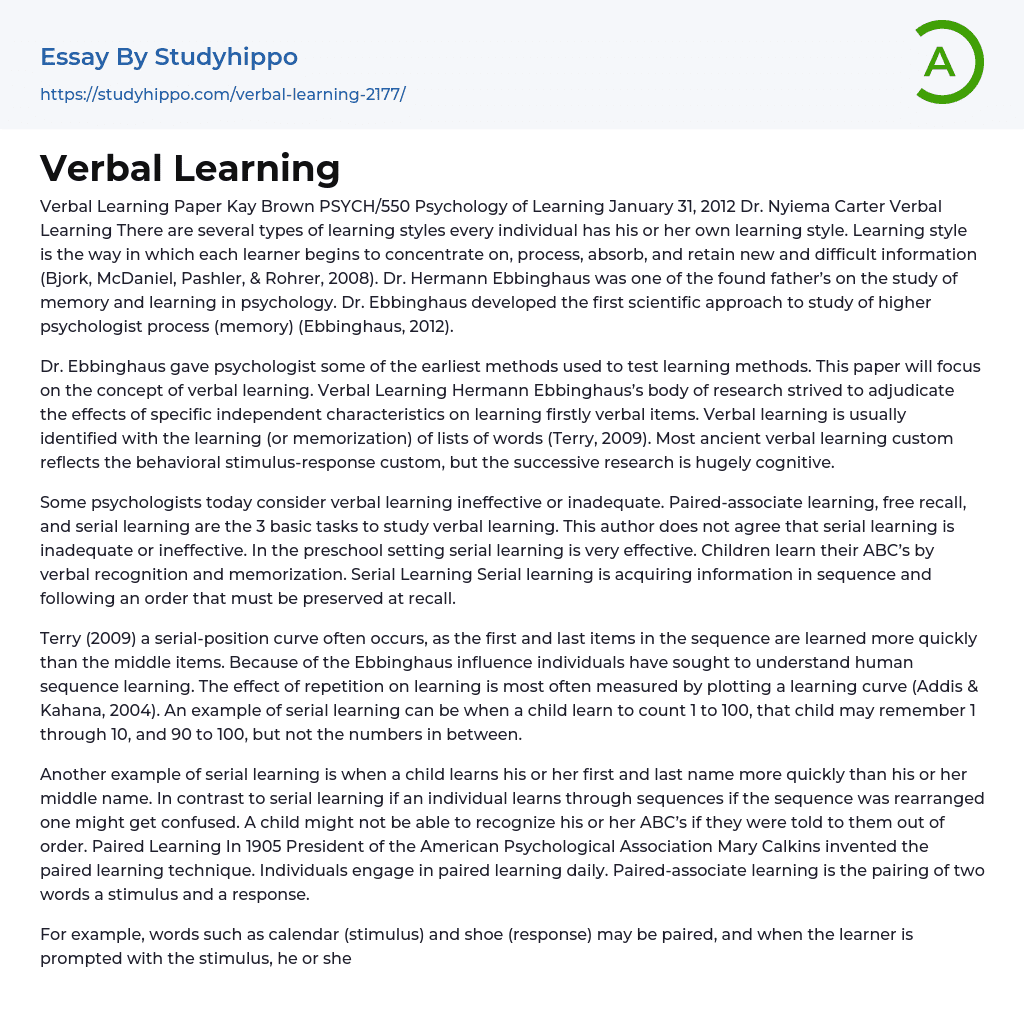

Verbal Teaching Aids Expressed in Speech, Sentences, Words Essay Example
There are several types of learning styles every individual has his or her own learning style. Learning style is the way in which each learner begins to concentrate on, process, absorb, and retain new and difficult information (Bjork, McDaniel, Pashler, & Rohrer, 2008). Dr. Hermann Ebbinghaus was one of the found father’s on the study of memory and learning in psychology. Dr. Ebbinghaus developed the first scientific approach to study of higher psychologist process (memory) (Ebbinghaus, 2012).
Dr. Ebbinghaus gave psychologist some of the earliest methods used to test learning methods. This paper will focus on the concept of verbal learning. Verbal Learning Hermann Ebbinghaus’s body of research strived to adjudicate the effects of specific independent characteristics on learning firstly verbal items. Verbal learning is usually identified with the learning (or memorization) of lists of words (Terry, 2009). Most ancient verbal l
...earning custom reflects the behavioral stimulus-response custom, but the successive research is hugely cognitive.
Some psychologists today consider verbal learning ineffective or inadequate. Paired-associate learning, free recall, and serial learning are the 3 basic tasks to study verbal learning. This author does not agree that serial learning is inadequate or ineffective. In the preschool setting serial learning is very effective. Children learn their ABC’s by verbal recognition and memorization. Serial Learning Serial learning is acquiring information in sequence and following an order that must be preserved at recall.
Terry (2009) a serial-position curve often occurs, as the first and last items in the sequence are learned more quickly than the middle items. Because of the Ebbinghaus influence individuals have sought to understand human sequence learning. The effect of repetition on learning is most often measured by plottin
a learning curve (Addis & Kahana, 2004). An example of serial learning can be when a child learn to count 1 to 100, that child may remember 1 through 10, and 90 to 100, but not the numbers in between.
Another example of serial learning is when a child learns his or her first and last name more quickly than his or her middle name. In contrast to serial learning if an individual learns through sequences if the sequence was rearranged one might get confused. A child might not be able to recognize his or her ABC’s if they were told to them out of order. Paired Learning In 1905 President of the American Psychological Association Mary Calkins invented the paired learning technique. Individuals engage in paired learning daily. Paired-associate learning is the pairing of two words a stimulus and a response.
For example, words such as calendar (stimulus) and shoe (response) may be paired, and when the learner is prompted with the stimulus, he or she responds with the appropriate word (shoe) (Deese and Hulse, 2001). In paired-associates learning, a list was considered memorized when the subject could respond to any stimulus from the list with its associated response. This was supposed to resemble real-life situations in which a person responded to a stimulus such as the sight of a person's face with a response such as a name (Intro psych, 2012).
Free-recall is simply recalling as many item presented on any given subject. Free-recall is not like serial learning, order recall is not necessary, which is why recall is called free recall (meaning unconstrained) (Terry, 2009). Free recall was impacted by repeating and rehearsal particular points
until they are tested. Rehearsal shows growth in children. Free recall is enhanced if the substance can be organized, meaning, if the material can be chunked or grouped together. Concept of Mnemonics
Mnemonic devices are various schemes, strategies, or procedures used to aid encoding and retrieval. Basically mnemonics can be defined as a memory tool. The theory behind applying mnemonics is to encode hard to remember information in a way that is easier to remember. Multiple mnemonics theories are based on visual pictures. Human brains progressed to interpret and code stimuli like colors, structures, images, smell, sound, touch, taste, emotions, positions, and language. Individual’s memories store all of these variables very effectively.
Mnemonics can be used to remember numbers; mnemonics even has methods to help individuals remember telephone numbers. Conclusion Every individual has his or her own learning style he or she prefers to use. Learning styles are a common way to group learners together. Every individual may or may not have more than one learning style. Some individuals a mixture of learning styles and some individuals may have one dominant learning style. Verbal learners learn with words, both written and spoken.
One’s learning style has significant influence on the way one learns. An individual’s dominant style will guide the way he or she learns. Verbal learners will have an experience, store the information, and the recall simply by hearing a trigger word. This author chose to attend University of Phoenix ground campus because she is not a verbal learner. The authors dominate learning style is spatial.
- Interpretation essays
- Plagiarism essays
- Analogy essays
- Learning English essays
- Coaching essays
- Critical Thinking essays
- homework essays
- Learning essays
- Library essays
- Listening essays
- Literacy essays
- Mentor essays
- Physical Education essays
- Project essays
- Reading essays
- Research essays
- Sex Education essays
- Social Studies essays
- Standardized Testing essays
- Study Plan essays
- Teaching essays
- Accident essays
- Awareness essays
- Benefits of Volunteering essays
- Challenges essays
- Childhood Memories essays
- Decision essays
- Driving essays
- Event essays
- Excellence essays
- Expectations essays
- Failure essays
- Farewell essays
- Flight essays
- Gift essays
- Growing Up essays
- Ignorance essays
- Improve essays
- Incident essays
- Knowledge essays
- Luck essays
- Memories essays
- Mistake essays
- Obstacles essays
- Overcoming Challenges essays
- Party essays
- Peace Corps essays
- Personal Experience essays
- Problems essays
- Sacrifices essays



